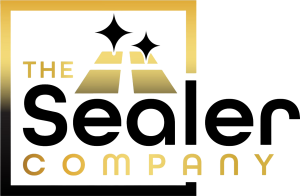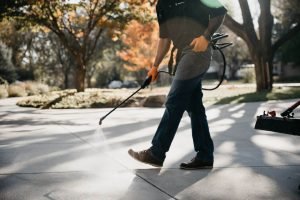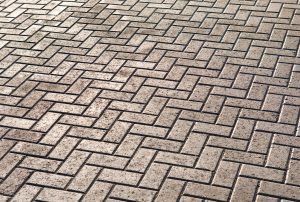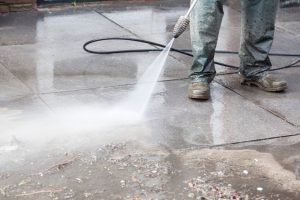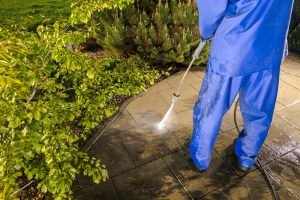Pressure washing is an incredibly useful tool when it comes to removing stains. From coffee spills to ink splatters, pressure washing can seemingly do the impossible and remove even the most stubborn of messes. But ironically enough, cleaning up a stain is often as difficult as creating one in the first place!
Fortunately, with the help of a pressure washer, there are eight common stains that can be eliminated from various surfaces with relative ease. In this article we will explore these eight stains and demonstrate how they can be removed utilizing pressure washing technology.
1.) Grease And Oil Stains
Grease and oil stains can be difficult to remove from any surface, but pressure washing is an effective tool for getting rid of them. The high-pressure water stream created by a pressure washer often provides enough force to break up and lift away stubborn grease or oil deposits. Additionally, the use of a cleaner in conjunction with the pressure wash may help to further loosen the residues while lifting it off surfaces.
Pressure washing is also beneficial because it doesn’t require scrubbing or extensive manual labor, making it much easier than other cleaning methods.
Pressure washing is especially useful when removing bird droppings due to its ability to quickly clean large areas without causing damage.
2.) Bird Droppings
The saying goes, ‘a stitch in time saves nine’.
When it comes to bird droppings and other tough stains, pressure washing is the best way to ensure they don’t become a long-term headache. By using a pressure washer with different nozzles or adjustments on the nozzle, you can effectively remove these tough stains without leaving any streaks behind.
Pressure washing helps to get rid of bird droppings efficiently and quickly. The powerful stream of water cuts through the stain, eliminating any trace of its existence while ensuring that none of the surface material is damaged in the process.
With an experienced hand at work and quality equipment, this method will do wonders for your property’s exterior by removing all sorts of tough stains like tree sap and gum.
3.) Gum And Tree Sap
Gum and tree sap can be difficult to remove from surfaces using traditional cleaning methods, but they are relatively straightforward to eliminate when pressure washing.
Before attempting to remove gum or tree sap with a pressure washer, it is important to understand the limitations of the pressurized water and select an appropriate pressure setting for removal:
1. A low-pressure setting of approximately 1,000 PSI should only be used on delicate surfaces such as wood or vinyl siding.
2. For concrete or brick sidewalks, a moderate-pressure setting between 1500–1800 PSI will generally suffice.
3. If gum or tree sap has been stuck in place for some time and refuses to budge, then upping the pressure level slightly may prove beneficial; however, it must not exceed 3000 PSI.
4. With any type of surface, always ensure that you keep the nozzle at least twelve inches away from the area being cleaned in order to avoid damage caused by too much pressure.
When it comes to removing stubborn stains such as gum and tree sap from hard surfaces like asphalt driveways and patios, high-pressure settings (above 2000 PSI) should be employed with caution since they could cause permanent discoloration depending on how long they remain in contact with the surface material before being removed successfully by the pressure washer.
Transitioning into the subsequent section about mold and mildew requires understanding that these types of stains also require special attention when utilizing a pressure washer while ensuring proper safety precautions are followed due to their hazardous nature.
4.) Mold And Mildew
A pressure washer is an effective tool for removing mold and mildew from various surfaces. Mold and mildew are types of fungi that thrive in damp and humid environments, and they can grow on a wide range of surfaces, including walls, roofs, decks, and sidewalks. Pressure washers use high-pressure water jets to blast away dirt, grime, and other contaminants from surfaces, including mold and mildew.
The force of the water dislodges the mold and mildew from the surface, making it easier to remove. Additionally, many pressure washers have detergent tanks that allow you to add a mold and mildew remover solution to the water, further enhancing the cleaning power. With the right technique and equipment, a pressure washer can effectively remove mold and mildew from various surfaces, leaving them clean and fresh.
5.) Grime And Dirt
Grime and dirt can be challenging to remove from the surfaces of decks, patios, driveways, siding, roofs, and other structures. Power washing or commercial pressure washing is a great way to get rid of these unsightly blemishes.
Here are four ways that pressure washers can help you clean grime and dirt:
1. They can quickly remove layers of dust and debris.
2. They provide enough power to clean difficult-to-remove substances such as grease and oil stains.
3. They make it easier to strip peeling paint and old finishes off wooden decking without damaging the wood itself.
4. Their high water pressure helps break up stubborn soils and allows them to be washed away with ease.
In addition to cleaning areas around your home or business premise, using a pressure washer on decks or outdoor furniture will help restore their original look by removing any deep stains caused by mold or mildew growing in damp environments over time.
By utilizing a powerful yet gentle stream of pressurized water they will do an effective job on most surfaces while also protecting them from further damage due to harsh chemicals or abrasive scrubbing techniques. With this technique, rust and corrosion can easily be removed from metal fixtures like railings or door frames without having to resort to sandblasting methods which could cause additional harm than good in some cases.
6.) Rust And Corrosion
Rust and corrosion can be removed with the help of a power washer or pressure washer. Pressure washing is a type of cleaning that uses high-pressure streams of water to clean surfaces.
A pressure washer is an important tool in getting rid of rust and corrosion, as it provides enough force to remove these substances from hard surfaces like concrete, brick, wood, metal, etc. The amount of pressure generated by a power washer depends on the type used; however, most have pressures ranging between 1000 psi – 4000psi (pounds per square inch). Depending on the severity of the rust or corrosion present on the surface, different levels of pressure can be used for effective removal.
Pressure washing is highly effective in removing stains caused by paint and varnish due to its ability to penetrate deep into small crevices around hardware fixtures and joints thanks to the pressurized stream of water it produces. Additionally, this method requires minimal effort compared to manual scrubbing.
7.) Paint And Varnish
Paint and varnish are often used to protect surfaces from environmental damage, but they can be difficult to remove when it is no longer needed.
In order to strip paint or varnish off of a surface, the traditional method involves using sandpaper and chemical strippers. Pressure washers can also be used to effectively clean away paint and varnish without causing any damage to the underlying material.
When removing paint from a driveway, for example, pressure washing with a low-pressure nozzle should first be done in order to break down the layers of coating. This should then be followed by high-pressure cleaning with a turbo nozzle in order to fully remove all traces of paint from the surface.
Oxidation and chalking frequently occur on painted surfaces due to prolonged exposure to weathering elements such as sun, rain, snow and ice. These effects can cause discoloration which may require specialized treatment depending on the severity of the oxidation or chalking present.
While some light oxidation and chalking may be able to be removed through pressure washing alone, more advanced cases might necessitate further steps such as power buffing or sandblasting prior to re-painting or sealing the surface.
Moving forward into this section, we will discuss how these treatments can help restore surfaces affected by oxidation or chalking.
8.) Oxidation And Chalking
Oxidation and Chalking are common stains that require high pressure washing to remove them from outdoor surfaces such as decks.
Pressure washing is a commercial process of cleaning a surface with pressurized water mixed with detergents or other cleaners, including surface-active agents. Advantages of using this method include:
- Quick removal of unwanted substances on the surface
- No need for manual scrubbing
- Ability to reach tight corners and hard-to-reach areas
- Environmentally friendly as no chemicals are used outside of non-toxic soap solutions
Pressure washing can be done at home but it’s recommended to hire professionals who have access to specialized equipment such as industrial grade pumps and hoses designed for heavy duty use.
Professionals also know how to adjust the pressure so that any treated area does not sustain damage during the process. Additionally, they will understand what type of nozzle should be used for different types of surfaces in order to get optimal results.
Having said that, transitioning into algae and moss requires an understanding of which types of surfaces harbor these organisms and what techniques should be applied in order to effectively clean them up.
9.) Algae And Moss
Algae and moss can form on surfaces exposed to moisture, sunlight and air, such as decks. Algae grows more quickly than moss and tends to be slimy or slippery in texture.
Pressure washing with water at high pressure is the best way to remove both algae and moss from outdoor structures like decks. According to Family Handyman, a deck cleaner that contains detergent should be used first with low-pressure water before using higher pressure settings.
If the wood surface of the deck is pressure treated, then care must be taken not to use too high a setting for the power washer so as not to damage it further. The correct amount of pressure used during cleaning will depend on how much attention you want to give each area; if there are stubborn areas where algae remains after several passes by the power washer then you may need to increase the water pressure slightly.
Careful consideration should always be given when deciding on an appropriate level of pressure since some types of wood may become damaged due to overzealous use of a power washer. Moving onto graffiti and chewing gum removal…
10.) Graffiti And Chewing Gum
Algae and moss can be difficult to remove from decks without the help of pressure washing. To effectively remove these stains, it is important to use a deck stripper before pressure washing a deck. A pressure washer sprayer, wand, and appropriate nozzle should also be used in order to keep the deck surface free from damage while still achieving maximum cleaning power.
Graffiti and chewing gum are two other types of stains that may require removal by means of pressure washing. Both substances have different properties which make them difficult to remove with traditional methods such as scrubbing. In this case, using a combination of hot water or chemical solutions along with pressurized water is necessary for successful removal.
Just like when removing algae and moss, care must taken to ensure the correct type of nozzle is used so that the surrounding surfaces do not get damaged during the process.
Conclusion
Pressure washing is an effective and efficient way to remove many stains from a variety of surfaces. It can be used on hardscapes such as concrete, brick, pavers, stucco, and asphalt; as well as decks, siding and fences made of wood or vinyl. Pressure washing should not take the place of regular maintenance cleaning but it can be used once every two years for optimal results.
To ensure proper use of pressure washing equipment there are certain precautions that must be taken. Make sure to read all instructions carefully before beginning a project and wear protective gear when using any chemical solutions with the machine. Additionally, if you are uncertain about how to operate the machinery seek professional assistance rather than attempting it yourself.
The question remains: How often do I need to use pressure washing? Depending on the amount of dirt buildup in your environment, frequency will vary depending on individual needs. Consider consulting professionals if you still have doubts about what is best for your property.
Frequently Asked Questions
What Type Of Surface Can Pressure Washing Be Used On?
Pressure washing is a method of cleaning that can be used on many different surfaces, such as wood decks, brick walls and concrete driveways.
It uses pressurized water to remove dirt and debris from hard-to-reach spots.
This type of cleaning is especially effective for removing stains, mold, mildew or other stubborn buildups.
As pressure washing does not require the use of harsh chemicals, it is an eco-friendly way to clean surfaces around the home or workplace.
How Often Should Pressure Washing Be Used?
Pressure washing is an effective technique for removing dirt, debris and stains from a variety of surfaces. The frequency with which it should be used depends on the type of surface and how much exposure to weathering or wear-and-tear that particular area has undergone.
For example, hard surfaces such as driveways, patios and sidewalks can usually handle more frequent pressure washing than softer materials like wood decks or siding that could become damaged by excessive use.
Ultimately, the best way to determine the ideal interval for pressure washing is to consult an experienced professional who can assess your specific situation and recommend a schedule based on their expertise.
Are There Any Special Precautions To Take When Using Pressure Washing?
Pressure washing is a common technique used for the removal of stains, but it should be used with caution. It involves using high-pressure water jets to remove dirt and debris from surfaces. The power of the waterjet can cause damage if not properly managed.
Therefore, special precautions must be taken when using pressure washing equipment, such as ensuring that all safety guards are in place and following manufacturer instructions carefully. Additionally, protective gear such as safety glasses, gloves and hearing protection should always be worn while operating this type of machinery.
Are There Any Materials That Should Not Be Used With Pressure Washing?
Satirically speaking, it may appear that pressure washing can do anything and everything when it comes to cleaning. However, there are certain materials which should not be used with this method.
Pressure washing involves using high-pressure streams of water to remove stains from surfaces, and while it is a powerful tool for removing dirt and grime, some materials may become damaged under its force.
Therefore, one should exercise caution before attempting to use the technique on more delicate items such as painted walls or wooden furniture.
Does Pressure Washing Require Any Special Equipment?
Pressure washing requires special equipment in order to be effective.
High-powered pressure washers are designed for more intense jobs, such as removing tough stains or mold from surfaces like brick and concrete.
Pressure washers come equipped with a nozzle that disperses the water at different pressures depending on what needs to be cleaned.
The user must also take into account the surface they are cleaning and use an appropriate detergent so as not to damage it when using high pressure.
